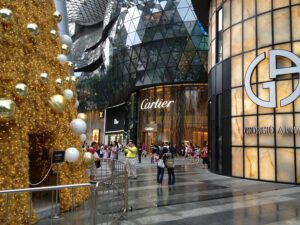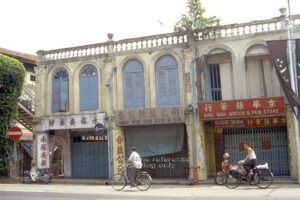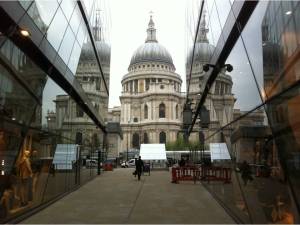Exploring the City-State’s Complex Layers
In a recent perusal of [polis], a revisit to Rem Koolhaas’ pivotal text, coupled with a critique in QRLS, reignited reflections on Singapore’s intriguing dichotomy. Donovan Gillman takes us on a journey back to 1986 when the city-state appeared compliant yet alienated, laying the groundwork for Koolhaas’ critique.
The Enigma of Orchard Road: A Microcosm of Singapore’s Development
Orchard Road, a linear slice of urban fabric, encapsulates Singapore’s economic prowess but raises questions about its historical disregard. Gillman reflects on the city’s seemingly flawless exterior, revealing an undercurrent of disquiet beneath the surface.

Orchard Road Xmas 2011
Deciphering Rem Koolhaas’ Critique
Potemkin Metropolis: Disneyland with the Death Penalty?
Koolhaas’ critique unfolds in S,ML,XL, portraying Singapore as a Potemkin Metropolis. William Gibson’s poignant description as “Disneyland with the Death Penalty” sheds light on Singapore’s unique development model. The city’s rigid, authoritarian ethos diverges from Western urban norms, challenging notions of cultural authenticity.
Singapore’s Tabula Rasa: Erasing History for Progress
The tabula rasa approach, erasing colonial and pre-colonial history, raises questions about the city’s identity. Koolhaas contends that Singapore’s constant state of urban renewal may perpetuate its artificial, Potemkin-like appearance.
Unraveling “Singapore Songlines”
Singapore’s Evolution: 30 Years of Tabula Rasa
“SIngapore Songlines: Portrait of a Potemkin Metropolis… or 30 Years of Tabula Rasa” delves into Koolhaas’ essay, connecting architecture to culture and politics. The essay explores the driving spirit behind Singapore’s transformation from 1965 to 1995.
The Impact of Tabula Rasa: Erasing History and Crafting a New Identity
The consequences of Singapore’s tabula rasa approach are evident in the erasure of landmarks and the creation of a pristine, First World city. Yet, the essay prompts questions about Singapore’s future – how will it respond to population growth and continue its development?

North Bridge Road towards the direction of Raffles City in 1986
The Complex Semiotics of Singapore: Consequence Without Cause
Western Semiotics in Singapore: A Complex Assemblage
Singapore’s adoption of Western semiotics creates a unique blend, honoring brands over creative talent. Koolhaas contends that without historical background, even originals become simulacrum, leaving us to ponder the consequences of this intricate cultural fusion.
As we delve into “Singapore Songlines” and Koolhaas’ prologue, the city-state’s complex evolution unfolds, inviting contemplation on the intersection of history, identity, and progress.

Tan Quee Lan Street on left of picture in 2011
The most evident outcome of adopting a tabula rasa, build-from-scratch approach in Singapore was the near-complete erasure of its colonial and pre-colonial history. In her essay, ‘A Fistful of Colours and Urban Renewal in Singapore,’ Suchen Christine Lim notes the disappearance of landmarks and the upheaval of entire communities. The image of the backward, chaotic, and lawless colonial Singapore gave way to a pristine, orderly, and decongested First World city, boasting a skyline, stock exchange, and an odourless river.
Looking ahead, with Singapore’s current population standing at five million, questions loom about how the city-state will address future population growth. Koolhaas, in ‘Singapore Songlines,’ posits that Singapore is destined to remain a perpetual Potemkin metropolis if its government maintains consistent policies, leading to a continuous state of urban renewal, forever resembling a recently erected city.
The term “songlines” in the book’s title draws inspiration from Bruce Chatwin’s work, suggesting that indigenous Australians, through their songlines, sang the land into existence. These songlines become the foundational myths and genealogy of a place’s development, emphasizing the inseparability of a people’s language, identity, and sense of self from their environment.
Originally part of the extensive work ‘S,M,L,XL,’ ‘Singapore Songlines’ emerged as a standalone monograph in 1995, shedding light on the city’s contemporary dynamics. Koolhaas, not confined to architecture, emerges as a provocative writer and thinker, inviting a deeper contemplation and interpretation of Singapore beyond mere admiration or disdain.
A noteworthy aspect of the Italian repackaging of ‘Singapore Songlines’ as a standalone book is Koolhaas’ prologue, offering a lens into his evolving perspectives over 15 years. He introduces provocations, challenging notions about the importance of democracy in shaping cities and communities. For Singaporeans uncomfortable with the idea that their city lacks history, Koolhaas contends in the prologue that ‘Singapore Songlines’ suggests otherwise, portraying the city’s artificiality as a style—a generic that garners substantial support.
The paradox of Singapore surviving Western denigration and becoming a sought-after destination for expats and corporations further complicates the narrative. Koolhaas questions whether Singapore’s appeal, with its cleanliness and rule of law, is indeed a paradox or a testament to the city’s unique success story.

King Wah Watch Shop House 1986
Koolhaas’s stance appears elusive, leaving uncertainty about whether he perceives Western admiration or “denigration” of Singapore as favorable. Consequently, ‘Singapore Songlines’ transcends being merely a book about Singapore; it morphs into a critique of the West. Koolhaas suggests that Singapore’s experiments two decades ago mirror contemporary Europe in areas like simplified education, medicine, and race relations, challenging the assumed differences between the two. The terms “simplified” and “hoped” in his discourse hint at potential concerns regarding the burgeoning similarities between Europe and Singapore.
However, Koolhaas undergoes a clear shift in perspective on one aspect. In the past, it seemed that Singapore would serve as a model for China’s development, but this proved wishful thinking. Instead, Singapore became a blueprint for Koolhaas’s own environment, with many of its themes now casting shadows on their local landscape. The choice of the word “haunt” suggests a certain unease – is Koolhaas apprehensive that Singapore might now influence numerous European cities?





